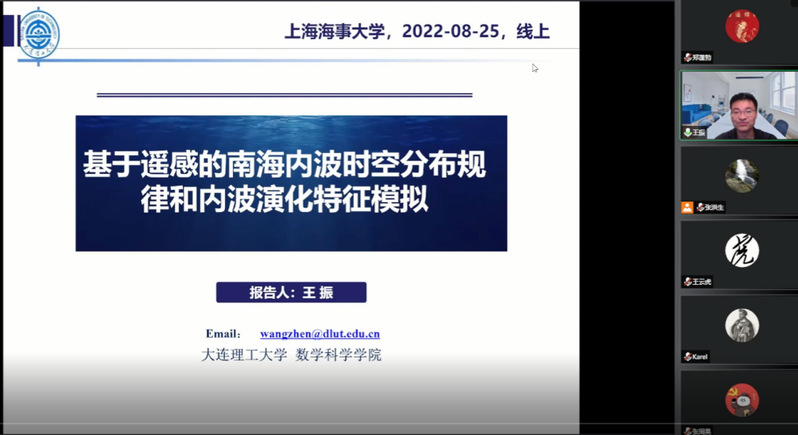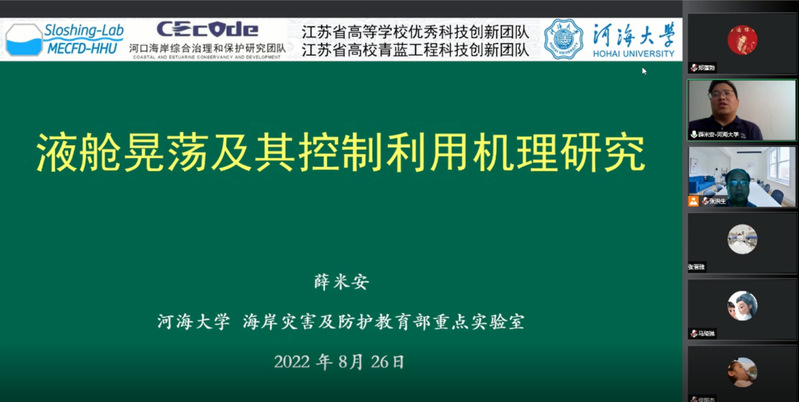Recently, three lectures were held by experts invited by Shanghai Full Penetration Offshore Energy Power Frontier Science Research Base. The topics were the simulation of spatio-temporal distribution and evolution characteristics of internal waves in the South China Sea based on remote sensing, the application of machine learning in coastal engineering, and the study of tank sloshing and its control and utilization mechanism.
Professor Wang Zhen from Dalian University of Technology, Professor Zhao Xizeng from Zhejiang University and Professor Xue Mian 'an from Hohai University gave academic reports respectively.
About 150 persons in charge of relevant functional departments, colleges, research bases and graduate students attended the conference.
The topic of Professor Wang Zhen's report is Simulation of spatio-temporal distribution and Evolution characteristics of internal waves in the South China Sea based on remote sensing.
This report takes internal waves in the northern part of the South China Sea as the research object, and uses machine learning to identify the imprint of internal waves on the ocean surface in satellite remote sensing images. Based on satellite data images of more than 10 years, the spatio-temporal distribution characteristics and rules of internal waves in the northern part of the South China Sea are analyzed.
The results of internal wave flume experiment in strongly stratified fluid are described.
Finally, Professor Wang Zhen introduced the relevant numerical simulation work on the interaction between internal waves and structures.
The title of Professor Xizeng Zhao's presentation is Application of Machine Learning in Coastal Engineering.
The main content of this report is to propose an actively controlled undulating horizontal plate breakwater based on machine learning technology, which can respond to incoming waves and update the wave mitigation strategy in real time.
The numerical flume model was embedded into the deep reinforcement learning framework, and the interactive conversation platform between the horizontal plate agent and computational fluid dynamics was built to find the appropriate wave-surface control strategy.
The title of Professor Shermian's presentation is Tank Sloshing and Its Mechanism of Control and Utilization.
The report focuses on tank sloshing, which is a key factor for the safe operation and maintenance of liquid storage structures such as large liquid cargo ships and oil or liquefied natural gas storage tanks. It focuses on two key scientific issues, namely, the control and utilization mechanism of tank sloshing.
The THREE DIMENSIONAL NUMERICAL MODEL DEVELOPMENT AND TEST TECHNOLOGY OF tank sloSHING, tank SLOshing characteristics AND DAMPING MECHANISM, AND THE DAMPING and DAMPING MECHANISM OF tuned LIQUID DAMPERS ON Marine STRUCTURES ARE mainly introduced.
In the interactive session, the three professors expressed their opinions on the relevant questions raised by the participants, and had a warm and extensive exchange and discussion with Professor Zhang Hongsheng of the School of Ocean Science and Engineering and the teachers and students present.
This seminar is co-sponsored by the College of Marine Science and Engineering and Shanghai Full Penetration Far-reaching Offshore Energy and Power Frontier Science Research Base (Training).

Figure 1. Professor Wang Zhen's academic report Simulation of Spatio-temporal distribution and Evolution characteristics of internal waves in the South China Sea based on remote sensing

Figure 2. Professor Xizeng Zhao's academic report on Application of Machine Learning in Coastal Engineering
 Figure 3. Professor Schermian's academic report on Tank Sloshing and its Control and Utilization Mechanism
Figure 3. Professor Schermian's academic report on Tank Sloshing and its Control and Utilization Mechanism
